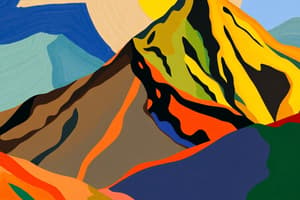Podcast
Questions and Answers
What type of landform is characterized by being broad, elevated, and surrounded by steep slopes or cliffs?
What type of landform is characterized by being broad, elevated, and surrounded by steep slopes or cliffs?
- Plateaus (correct)
- Valleys
- Mountains
- Plains
Which landform is known for being low-lying areas between hills or mountains?
Which landform is known for being low-lying areas between hills or mountains?
- Rivers
- Plateaus
- Valleys (correct)
- Mountains
What process can lead to the formation of plateaus?
What process can lead to the formation of plateaus?
- Erosion by rivers
- Deposition of sediments
- Volcanic activity
- Tectonic movement (correct)
Which landform type can provide fertile land for agriculture and habitats for various plant and animal species?
Which landform type can provide fertile land for agriculture and habitats for various plant and animal species?
What landform type is essential to comprehend the natural world and the complex interactions between Earth's physical features and human populations?
What landform type is essential to comprehend the natural world and the complex interactions between Earth's physical features and human populations?
Flashcards
Plateau
Plateau
Elevated landforms with steep sides, formed by tectonic uplift or volcanic activity.
Plains
Plains
Expansive, level areas of land, formed by erosion or sediment deposition.
Mountains
Mountains
Uplifted landforms, created by colliding tectonic plates, affecting climate and weather patterns.
Valley
Valley
Signup and view all the flashcards
Geography
Geography
Signup and view all the flashcards
Study Notes
Introduction
Geography is the scientific study of the Earth's physical features and the relationship between humans and their surroundings. It involves the examination of various aspects of the Earth's surface, including mountains, plains, plateaus, and valleys. This article delves into these key geographic features, exploring their unique characteristics, formation processes, and significance within the broader context of Earth's diverse landscapes.
Mountains
Mountains represent some of the most prominent and visually striking landforms on Earth. They form when massive quantities of rock shift and compress over millions of years due to tectonic activity. This compression forces the rocks upward, creating towering peaks and ridges. Mountain ranges often follow convergent boundaries between tectonic plates, where one plate is forced beneath another. Examples of mountain ranges include the Himalayas, Andes, Rockies, and Alps. Mountains play a crucial role in shaping the Earth's climate, affecting wind patterns, precipitation, and temperature fluctuations.
Plains
Plains, also referred to as lowlands or flatlands, are expansive, level areas of relatively unbroken terrain characterized by their lack of significant topographic relief. They may occur through various geological processes, such as erosion or sediment deposition. Plains cover approximately half of all habitable land surfaces worldwide, providing vital resources for agriculture, forestry, mining, and energy production. Notable examples of plains include the Great Plains of North America, the Russian Plain, and the North German Plain.
Plateaus
Plateaus are broad, elevated landforms surrounded by steep slopes or cliffs. They form when the Earth's crust experiences uplift, causing the land surface to become higher than its surrounding areas. Plateaus can be formed through volcanic activity, tectonic movement, or the accumulation of sediments. Some famous plateaus include the Tibetan Plateau, the Colorado Plateau, and the Deccan Plateau in India. Plateaus often have unique climates and ecosystems, supporting diverse flora and fauna.
Valleys
Valleys are low-lying areas between hills or mountains, often formed by the erosive action of rivers or streams. Over time, water carves through rock, gradually deepening and widening the valley floor. Valley formation can also occur through tectonic processes, such as the uplift of mountain ranges or the subsidence of earth's crust. Valleys can provide fertile land for agriculture, as well as habitats for various plant and animal species.
In conclusion, understanding the geography of mountains, plains, plateaus, and valleys is essential for comprehending the natural world and the complex interactions between Earth's physical features and human populations. These landforms not only shape our landscapes and influence our daily lives but also hold valuable resources for sustainable development and environmental stewardship. As geography continues to evolve through natural processes and human intervention, our knowledge and appreciation of these unique features will only grow.
Studying That Suits You
Use AI to generate personalized quizzes and flashcards to suit your learning preferences.





